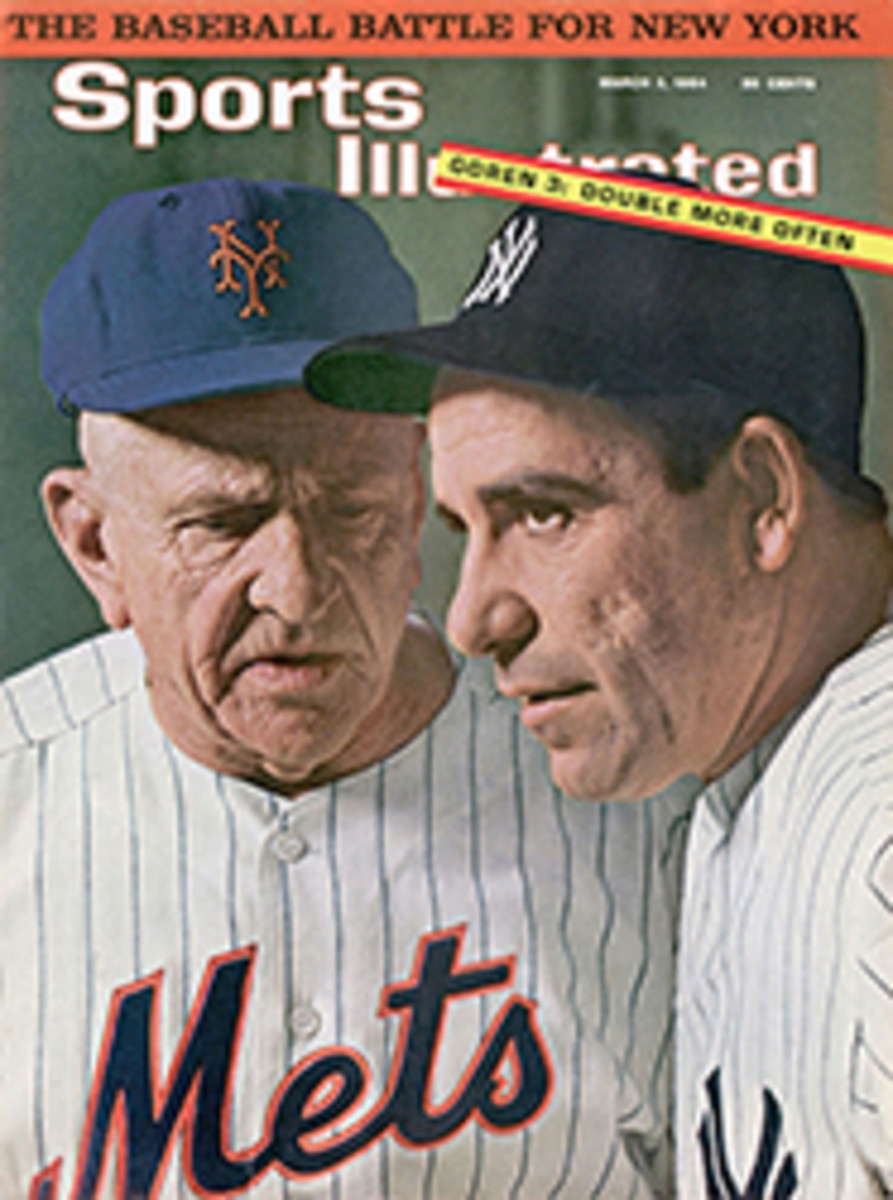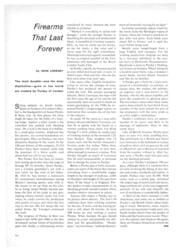
SWOOP OF A SECRET WEAPON
Of the hundreds of stock-car races held in the U.S. each year, none commands more respect from the public than the fast, demanding Daytona 500-miler. The vast Daytona International Speedway is the site of the year's first high-speed, closed-circuit race and two of the Big Three car manufacturers (General Motors pretends not to care about racing, but does) spend huge sums getting ready to compete there. How they make out at Daytona, they realize, can affect their showroom traffic for months to come. Says one Michigan automan: "Whatever happens in Daytona is the talk of all Detroit 20 minutes later."
At 20 minutes past 4:15 o'clock last Sunday, then, all Detroit was talking about one of the biggest industry upsets in years. Chrysler Corporation's Plymouths, long considered the patsies of long-distance stock-car racing (although they have done well on short tracks), had suddenly demolished the supremacy of the Ford Motor Company. Plymouths had finished 1, 2, 3 in the three-and-a-quarter-hour race, with the nearest Ford in fourth place, the nearest Mercury in sixth. And in winning, curly-haired, 26-year-old Richard Petty had rather awesomely lapped the field. Despite 20 minutes of slow travel under caution lights flashed on for three accidents, Petty averaged 154.334 mph to better Fireball Roberts' 500 record by almost two miles per hour.
Chrysler's little scheme to dominate stock-car racing began almost three years ago when the 1964 Plymouth-Dodge body (except for superficial styling differences, the same body is used for both cars) first went on the drafting table. But the most important part of the plan was put into action 18 months ago when Chrysler dusted off and redesigned an engine type it had abandoned in the late 1950s.
Where most modern engines in American-made cars have wedge-shaped combustion chambers over each cylinder, Chrysler's reborn racing engine had domed heads the shape of inverted cereal bowls. The snap, crackle and pop such a design gives to an engine is formidable, and when that engine was placed into the new streamlined Plymouth-Dodge body, a smile spread over the face of Ronnie Householder. Ronnie's title is staff engineer in charge of special events, which means he is in charge of racing at Chrysler, another way of saying in charge of attempting to defeat Ford.
"We have nothing to do with the body design," said Householder, "but I cannot deny that we are rather pleased at how well our separate efforts have complemented one another." Householder claimed the new engine developed only about 400 horsepower, but few at Daytona accepted that. "We're 400 ourselves," said a Ford man, "and they've got us by 100 horsepower if they've got us by 10."
Whatever its true potential, the secret of Chrysler's new engine was so well kept that company publicity men did not even know about it until three days before the cars were delivered to Daytona. It was there, of course, that Ford first saw them. Ford had won the first three positions at the Riverside (Calif.) 500 in January against other 1964 Plymouths and Dodges and had no reason to worry about Daytona. "When they saw what we'd brought along this time," said a Chrysler Corporation vice-president, understating the case, "I think they felt a certain dismay."
Ford's dismay deepened as Plymouths turned on the speed. In practice one Plymouth went up to 175.370 mph, another made the two-and-a-half-mile circuit of the track at 174.910. The best efforts by the company-sponsored Fords and Mercurys (which, like Plymouth and Dodge, use the same basic engine and body) were all under 170. Probably the most infuriating thing that happened before Sunday's race came on Friday: in a 100-mile qualifying race, Richard Petty finished third in his Plymouth even though he was out of gas in the last two miles of the final lap. He was just beaten by a Dodge and a Plymouth which passed him inches in front of the finish line. Ford was a late fourth.
Adding to Ford's frustrations was the fact that, because of some aerodynamic ingredient in the Plymouth's and Dodge's body shapes, they could not be effectively slipstreamed—or drafted, as they say in Daytona. Slipstreaming—tailgating the car ahead as closely as a driver's nerves permit—enables the trailing car to match the leading car's speed at substantially lower engine revolutions. This means that a less powerful car can often keep up with its betters, and that an equal car can travel at an engine-nursing pace.
Furthermore, a move by Ford to throw a really hot overhead camshaft engine into later races seemed blocked when Bill France, president of both the Daytona Speedway and NASCAR, the stock-car sanctioning body, said such an engine would not be allowed to race on NASCAR tracks. Jacque Passino, Householder's counterpart at Ford Division, growled, "We'll see about that," and said the overhead camshaft engine would indeed appear.
Since it was just about too late for anything else, the Ford men indulged in some high-octane griping. John Holman, who heads up the Ford stock-car racing effort, went immediately to the local Plymouth dealer and demanded delivery of four of the new engines. Stock-car racing rules, as established by NASCAR, require all equipment to be generally available to the public, and Holman was sure the new Chrysler engine was not. But it was. The dealer sold him one. Someone else close to the Ford team then wondered aloud if the low profile of the Plymouths and Dodges was within allowable limits. That too checked out. (Charges, countercharges and professional intolerance are as much a part of stock-car racing as gasoline and checkered flags. The situation was so competitive, indeed, that even in their hours of glory, the Dodge and Plymouth people did not speak to one another beyond the bare necessities of civility.)
Some badly needed cheering was given the Ford men Saturday evening by Henry Ford II himself, who assembled his Daytona forces and told them, in effect, to stop worrying and start planning for the races ahead. He was, he said, behind them for the long haul and would see that they got the hardware with which to win.
Passino, a veteran of lean racing years as well as good ones, even managed to squeeze out a quip. "After all," he said, "stock-car racing is just a carnival. To get people out you have to throw some Christians to the lions. This year it seems to be our turn to get thrown."
Still, the best joke in town was the one about the Le Mans start. If they had that at Daytona instead of the usual rolling start, it went, everyone would run and get into the nearest Plymouth. But if there was a kind of despair in the conversations of those not connected with the Chrysler cars, all hands worked diligently to produce respectable speeds. The cars racing Sunday stayed behind a high fence, and there was a strict security check of all those allowed inside. Each day the cars would roar out of the compound like circus lions and tigers out for air and exercise, and after they had run their practice laps they were returned to quarters. Then, no matter what, it seemed, mechanics began to take them apart, removing whole engines and casting them aside like a dentist pulling teeth, dropping out transmissions, prying into differentials, realigning front ends, rebalancing wheels.
Always the mechanics were pressed for time because of a rule that forbade any work after 5 p.m. So, within permissible hours, they remade Paul Goldsmith's Plymouth after a slipping clutch allowed the engine to over-rev and burst as Paul led a preliminary race. When they had the time, drivers and mechanics from the Ford and Mercury teams stood around, hands in pockets, looking glumly down at the Plymouths and Dodges.
The word that Chrysler had the hot car this year was not long getting around the South, where stock-car racing thrives as a form of self-identifying entertainment. If you own a Plymouth, you get out to the tracks and root, by George, for racing Plymouths. Racing writers were genuinely impressed by the Plymouths and Dodges, and Chrysler itself took big newspaper advertisements after the cars had qualified in the 170s. Consequently, by Saturday night nearly every one of the city's 40,000 beds for transients was taken (there were still a few available for $45) and for late arrivals the Venus Lounge on the road to the Speedway stayed open for dining and dancing until 5 a.m. Leaving at closing time would put one in good position to get a head start on what developed into a heroic traffic jam Sunday morning—better, indeed, than last year's, when some fans were three days finding their abandoned cars after the race was over. Altogether, Daytona's population of 75,000 had increased almost 100% by race time, and its pocketbook had been stuffed with some 3 million out-of-town dollars.
When the race began, Ford could only hope that recent history would repeat itself. Last year Chevrolets had beaten Fords in practice and qualifying races, but had failed mechanically in the 500. But Richard Petty, as he pulled on his board-stiff fireproof coveralls before he got into his blue Plymouth, had no worries on that score. "I don't think I've ever gone into a race feeling more confident about the outcome," he said.
Which is maybe carrying prescience a little too far. Not only did Petty's Plymouth carry him to victory, he led the pack for the last 375 miles and wound up a full lap ahead of the next car (Jimmy Pardue's Plymouth) and two full laps ahead of the third car (this time Paul Goldsmith's Plymouth). Petty had broken in a new engine on the parade laps. Back there in the distance came the Fords, the Mercurys and, little as the Chrysler people wanted to talk about it, the Dodges that had looked so promising earlier in the week. But Chrysler had enough to cheer about without being greedy. With the exception of one Dodge, which went out of the race after its right front tire blew, all the Plymouth and Dodge factory cars finished the race.
Ford, of course, was plenty blue, but there had been moments when it looked like all was not lost. A. J. Foyt, the Indianapolis "500" winner in 1961 and one of the world's best race drivers in any kind of car, had held his factory Ford up with the front-running Plymouths for 60 of the middle laps. The Plymouth people later sniffed that he had finally got the hang of riding in their vacuums and had no business being that near the front. In any event, all was clearly lost to Ford when Foyt's engine quit running, just like that, on the 127th of the race's 200 laps. Ford's other big gun, Fireball Roberts, had lost his power way back at the beginning in the 13th lap.
Petty earned about $35,000 and became the second man in his family to win the Daytona 500. His father, Lee, won at the Speedway in 1959, the year it opened (Lee's prize had been a mere $19,050).
Richard's next assignment for Plymouth will be the Atlanta 500 in April. That could be interesting, he said.
"If Ford shows up with a real kit—you know what I mean?—then that race will be a personal race between the drivers. But if Ford don't do anymore than they did this time, I don't guess there'll be much difference in the final result." But as Henry Ford had been saying the night before, there were going to be some changes made. Snap, crackle, pop.
PHOTO
PETER CUSTER
Victorious Plymouth (left) driven by Richard Petty takes the high road in a warmup race, displaying winning 500 form by lapping three Fords
PHOTO
Cigar-chewing Ronnie Householder, Chrysler racing chief, masterminded Daytona victory.

